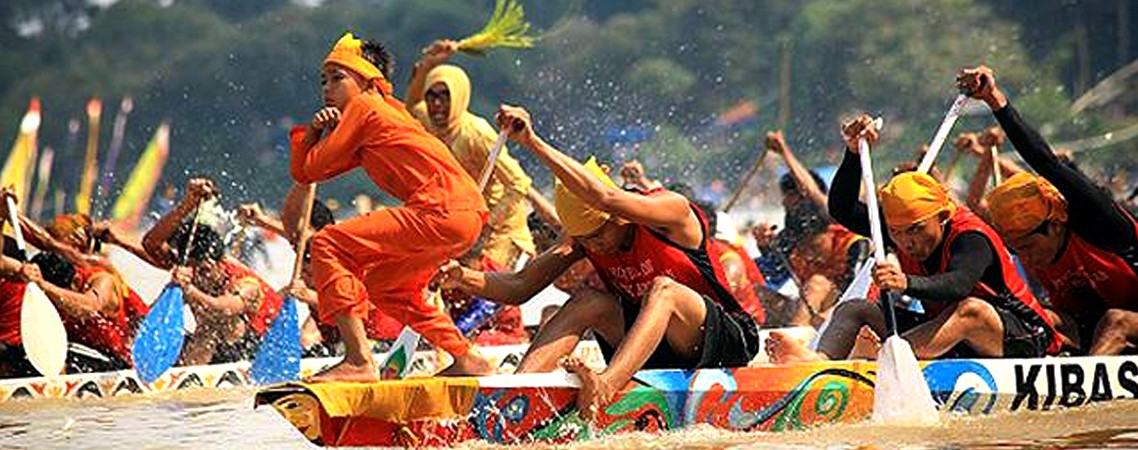Pacu Jalur is one of the oldest and most cherished cultural traditions from Kuantan Singingi Regency in Riau Province, Indonesia. This longboat rowing race is not only rich in history, but it has also recently captured global attention after going viral on social media—thanks to the appearance of a young dancer at the tip of the boat, a phenomenon now trending on TikTok as “Aura Farming.”
But before diving into how this tradition became an online sensation, it’s worth exploring the cultural roots and long-standing legacy of Pacu Jalur as a powerful symbol of unity and identity for the people of Kuantan Singingi.
From River Lifeline to Social Identity

The history of Pacu Jalur dates back to the 17th century, when the people of Rantau Kuantan—stretching from Hulu Kuantan District to Cerenti—relied on rivers as their main transportation route. The longboats, known locally as jalur, were crafted from whole tree trunks and used to transport agricultural goods like bananas and sugarcane. Some boats were large enough to carry up to 60 people.
Over time, the function of these jalur evolved. The boats began to be adorned with carvings of dragons, snakes, or tigers, and outfitted with ornaments such as umbrellas, ropes, and decorative crests (selembayung). These embellishments weren’t merely for visual appeal—they were markers of social status. Only nobles and datuk (village elders) owned ornately decorated jalur.
The Birth of the Pacu Jalur Tradition
Around a century later, inter-village rowing competitions began to emerge. Initially, these races were held in celebration of major Islamic holidays such as the Prophet Muhammad’s birthday (Maulid Nabi) and Eid al-Fitr. During Dutch colonial rule, Pacu Jalur was also incorporated into the annual celebration of Queen Wilhelmina’s birthday on August 31.
The tradition was disrupted during the Japanese occupation and periods of armed conflict, but it experienced a revival in the 1950s. Since then, Pacu Jalur has become an annual event held every August to commemorate Indonesia’s Independence Day.
Team Structure and Roles in Pacu Jalur

A jalur (longboat) typically measures between 25 and 40 meters in length and can carry up to 60 paddlers. Each team consists of several key roles:
- Anak Pacu: The main rowers who power the boat forward.
- Anak Jaga: Responsible for maintaining rhythm and balance during the race.
- Anak Onjai: Positioned at the rear, helping to keep the boat steady.
- Anak Coki: A young dancer stationed at the front of the boat, who energizes the team and is believed to bring good fortune.
It is the spirited performance of the Anak Coki that has recently captured global attention.
Going Viral with the Aura Farming Trend
The Pacu Jalur tradition went viral after a TikTok video showed a confident young dancer (Anak Coki) performing at the tip of a fast-moving boat, set to the track “Young Black & Rich.”
With bold, captivating movements, the dancer was said to emit a strong “main character aura,” fitting into a popular Gen Z concept known as Aura Farming—a term that describes someone’s magnetic presence and charm.
The video drew attention from international content creators, sparking curiosity about the origins of this unique tradition. As a result, Pacu Jalur reemerged in the spotlight—not just as a rowing competition, but as a cultural expression reaching audiences around the world.
The Spirit of Cooperation in Building a Jalur
Constructing a single jalur can cost up to IDR 100 million (approx. USD 6,000), including decorations and training expenses. However, these costs are covered collectively through gotong royong—a traditional practice of communal cooperation that reflects the community’s solidarity and deep respect for the tradition.
The rowers also undergo months of intense training to develop unity and synchronization. This highlights that Pacu Jalur is not just about speed, but also about teamwork and collective strength.
Pacu Jalur Festival: A Cultural Tourism Magnet
Every August, the city of Teluk Kuantan transforms into a festive hub. Thousands of spectators line the banks of the Batang Kuantan River, cheering as dozens—sometimes hundreds—of jalur teams from surrounding villages compete with passion. The sound of cannons, cheers, and the vibrant colors of costumes bring an electric energy to the event.
The Riau Provincial Government has made Pacu Jalur a flagship annual tourism attraction. The event not only draws domestic tourists but also captivates international visitors, including those from neighboring countries like Malaysia, Singapore, and Thailand.
Pacu Jalur is proof that cultural heritage doesn’t have to be rigid or outdated. It can evolve, adapt with the times, and stay relevant. What began as a mode of river transport grew into a status symbol, then became a competitive sport, and now stands as a global cultural icon—thanks to the power of social media.



















